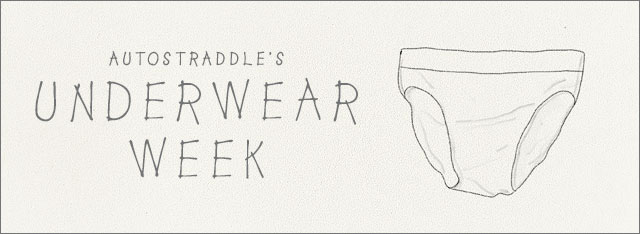
HELLO and welcome to the 66th installment of Things I Read That I Love, wherein I share with you some of the longer-form journalism/essays I’ve read recently so that you can read them too and we can all know more about Jehovah’s Witnesses! This “column” is less feminist/queer focused than the rest of the site because when something is feminist/queer focused, I put it on the rest of the site. Here is where the other things are.
The title of this feature is inspired by the title of Emily Gould’s tumblr, Things I Ate That I Love.
This week we have TWO entire TIRTLs for you. The first is a traditional TIRTL, the second is themed for Underwear Week. Enjoy!
Leaving the Witness (February 2013), by Amber Scorah for The Believer – This was fantastic, truly, just amazing. It’s about a girl who was raised Jehovah’s Witness and then moved to China to convert people there and her whole world opened up.
Big Bang Theories: Violence on Screen (February 2013), by A.O. Scott, Manola Dargis, Alessandra Stanley and Chris Suellentrop for The New York Times – A really good four-part situation about violence onscreen, which is something I’ve been thinking about lately A LOT because marathoning TV shows on Netflix, as I often do, really makes your head explode from all the head explosions! —> “As violence permeates what we see on movie, TV and video-game screens, critics for The Times consider the impact. A.O. Scott and Manohla Dargis, co-chief movie critics, explore the history and mythology of on-screen violence. The TV Watch columnist Alessandra Stanley differentiates between different types of violence on TV, while Chris Suellentrop puts video-game carnage in perspective.”
A Path To Disaster (April 1994), by Susan Karlin for Entertainment Weekly – This week in “accurate premonitions,” an early piece about Edward Furlong who I used to be super into.
The Crime of His Childhood (March 2013), by Wendell Jamieson for The New York Times – “It was the crime of my childhood, of another, rougher Park Slope, and in the end it would destroy a family. We didn’t know the Mieles, but I always wanted to know what happened, and what happened afterward — how they had held it all together, or not. I wanted to know what happened to the “crazy man,” and who he was. But most of all, I wanted to know what had become of that little boy.”
The Cruelest Crime (The Sexual abuse of children: the victims, the offenders and how to protect your children) (December 1984), by Cheryl McCall for LIFE Magazine – It’s amazing to me how much of this conversation was new when this was written, just how different social attitudes were. I remember when I was in middle school, very early 90’s, sex abuse was becoming a thing more people were talking about, like Oprah and Roseanne were talking about it, and we were being warned/educated about it in school. In this piece, none of the child abusers are being charged with crimes because their victims are “too young to be reliable witnesses.” Certainly things aren’t “good” now by any means, but I was surprised by the things in this article that were stated like it was new information.
Hunger Pains (June 1996), by Joyce Ross for Allure, includes photographs of ill patients with eating disorders by Mary Ellen Mark – “A rare look inside an eating‑disorder clinic reveals the hard‑fought recovery of women who’ve spent their lives battling anorexia and bulimia.”
That’s Not A Droid, That’s My Girlfriend (February 2013), by Aubrey Belford for The Globe & Mail – This is at first another article about lonely men with robot girlfriends, but then it gets into lots of artificial intelligence stuff, like the science of it and current advancements in the field and leading researchers. I kinda wish they’d mentioned Battlestar because they get into how robots are portrayed as enemies in American pop culture but friends in Japanese pop culture, but other than that I found this very intriguing.
The Sins of The Fathers (May 1995), reporting by Barbara Maddux, text by Claudia Glenn Dowling for LIFE Magazine – In 1987, LIFE published a piece about the Linda and Dean Damm and their family, who were homeless in Los Angeles. Readers responded with “$9,000, two used cars, toys and job offers. A plastic surgeon volunteered to remove Linda’s tattoos. Actress Cindy Williams donated bunk beds.” Within four months of receiving those gifts, the family was back on the street, the parents having spent it on drugs and alcohol. They catch up with the Damms eight years later to find them much worse off than they’d been in 1987. With photographs by Mary Ellen Mark.
Diary: Fan Fiction (March 2013), by Katherine Arcement for The London Review of Books – In which a college student explains fan fiction to the readership of The London Review of Books.
The Last Man Up (March 2013), by Christopher Solomon for Runner’s World– “Like a lot of things in Alaska, the annual Mount Marathon Race in Seward is famously brutal, even dangerous. Which is precisely why Michael LeMaitre ran it–the last day he was seen alive.” (In addition to the story itself, there’s also just some really beautiful writing in there about Alaska, FYI.)
The Extraordinary Science of Addictive Junk Food (February 2013), by Michael Moss for The New York Times Magazine – I gave up most processed foods a few years ago when I recognized the absolute correlation between eating processed foods and having a series of uncomfortable stomach-feelings as well as overall uncomfortable life-health-feelings. I was lucky enough to be raised in a no-junk-food household as well. But not everybody has that choice, and that’s a big problem! Anyhow, basically this is about how that stuff is for real addictive, and the actions that haven’t been taken to stop it and the science that goes into making cheap and terrible food.
Here’s some special TIRTL links for Underwear Week!
But What If You Get Hit By A Taxi? (April 2007), by David Colmon for The New York Times – “Novelty underwear, for decades the butt of jokes and the joke of butts, has, in the last two to three years, turned into a serious business, capturing a significant share of the $1.1 billion men’s knit-underwear (that is, excluding boxers) market. In all their goofy glory, briefs in bright colors, zany prints, new materials and daring cuts are undermining the classic white brief’s long-held status as king of the hill…. It is hard to believe, so eyebrow-raisingly offbeat, and atypically masculine, are many of the selections.”
My Father’s Fashion Tips (July 2007), by Tom Junod for GQ – I linked to this in a previous TIRTL, but it is really just super-good, and if you wanted to re-read it today you could pay special attention to his father’s rules about what kind of underwear men should be wearing.
An Open Letter to Urban Outfitters on Columbus Day (October 2011), by Sasha Houston Brown for Racialicious – “I doubt that you consulted the Navajo Nation about using their tribal name on sophisticated items such as the “Navajo Hipster Panty”. In fact, I recently became aware that the Navajo Nation Attorney General sent your company a cease and desist letter regarding this very issue. I stand in solidarity with the Navajo Nation and ask that you not only cease and desist selling products falsely using the Navajo name, but that you also stop selling faux Indian apparel that objectifies all tribes.”
Behind, Beneath and Between: Tracing The Thong (August 2011) by Natasha Stagg for Dis Magazine – The history of the thong!
Bad Panties (September 2008), by Alice Bradley for Nerve.com – “Bad underwear is different. No longer comfortable or attractive, bad underwear is worn on laundry days, or when you have the worst period in menstrual history and do not want to destroy a good pair. You only wear the bad underwear when you are staying inside. It doesn’t matter how much clothing you plan to wear over it; the bad underwear stays at home. No one may see the bad underwear, ever… This rule is what compelled me to wear my ugliest underwear on the night in question.”
Uniqlo: Cheap, Chic and Made For All (June 2012), by Jeff Chu for Fast Company – “‘Our underwear used to just be cotton, but we wanted to see if we could create something out of synthetics,” he says. With the Japanese materials-science company Toray Industries, Uniqlo created a stretchy fabric called Silky Dry, a name that pretty much explains how it’s supposed to feel, even when the wearer is Sweaty Gross. (Uniqlo is in the process of rebranding it “Airism.”) “I wear it every day,” Yanai says. “It makes customers happy–and that makes me happy.”
Lingerie’s Great Leap Forward (August 1986), by Lisa Belkin for The New York Times – A look at the lingerie industry during a transformative time (a year after the introduction of the racer-back bra, apparently!) when women’s shopping habits were changing and everybody was buying more and better underthings. Factoids include “readers of Ms. magazine buy more lingerie than the readers of Cosmopolitan.”
The Joy of Spanx (June 2004), by Candice Dyer for Atlanta Magazine – “Sara Blakely was fussy with her design. She demanded a cotton crotch and a waistband made with special webbing that does not feel like a tourniquet. “All of these men were just looking at me when I made these specifications,” she says. “So I leaned over and said, ‘Have you ever spent an entire day in a pair of control-top pantyhose?’ That shut them up.”
Calvin’s World (September 1995), by Michele Ingrasia for The Daily Beast – Remember what a HUGE controversy it was when those Calvin Klein underwear ads came out that everybody said reminded them of kiddie porn? I do. This is about that.
What It’s Like to Be a Lesbian in the Lingerie Industry (November 2012), by Lingerie Lesbian for Jezebel – “The funny thing about being a lesbian in the lingerie industry is that it feels like a paradox: I see versions of myself everywhere and nowhere at the same time.”








